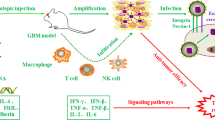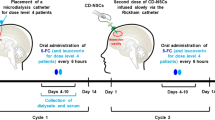Abstract
Previously, we have shown that the genetically modified human neural stem cells (NSCs) show remarkable migratory and tumor-tropic capability to track down brain tumor cells and deliver therapeutic agents with significant therapeutic benefit. Human NSCs that were retrovirally transduced with cytosine deaminase (CD) gene showed remarkable ‘bystander killer effect’ on the glioma cells after application of the prodrug, 5-fluorocytosine (5-FC). Interferon-β (IFN-β) is known for its antiproliferative effects in a variety of cancers. In our pilot clinical trial in glioma, the IFN-β gene has shown potent antitumor activity in patients with malignant glioma. In the present study, we sought to examine whether human NSCs genetically modified to express both CD and IFN-β genes intensified antitumor effect on experimental glioma. In vitro studies showed that CD/IFN-β-expressing NSCs exerted a remarkable bystander effect on human glioma cells after the application of 5-FC, as compared with parental NSCs and CD-expressing NSCs. In animal models with human glioma orthotopic xenograft, intravenously infused CD/IFN-β-expressing NSCs produced striking antitumor effect after administration of the prodrug 5-FC. Furthermore, the same gene therapy regimen prolonged survival periods significantly in the experimental animals. The results of the present study indicate that the multimodal NSC-based treatment strategy might have therapeutic potential against gliomas.
This is a preview of subscription content, access via your institution
Access options
Subscribe to this journal
Receive 12 print issues and online access
$259.00 per year
only $21.58 per issue
Buy this article
- Purchase on Springer Link
- Instant access to full article PDF
Prices may be subject to local taxes which are calculated during checkout







Similar content being viewed by others
References
Fine HA, Dear KB, Loeffler JS, Black PM, Canellos GP . Meta-analysis of radiation therapy with and without adjuvant chemotherapy for malignant gliomas in adults. Cancer 1993; 71: 2585–2597.
Benedetti S, Pirola B, Pollo B, Magrassi L, Bruzzone MG, Rigamonti D et al. Gene therapy of experimental brain tumors using neural progenitor cells. Nat Med 2000; 6: 447–450.
Aboody KS, Brown A, Rainov NG, Bower KA, Liu S, Yang W et al. Neural stem cells display extensive tropism for pathology in adult brain: evidence from intracranial gliomas. Proc Natl Acad Sci USA 2000; 97: 12846–12851.
Barresi V, Belluardo N, Sipione S, Mudo G, Cattaneo E, Condorelli DF . Transplantation of prodrug-converting neural progenitor cells for brain tumor therapy. Cancer Gene Ther 2003; 10: 396–402.
Shimato S, Natsume A, Takeuchi H, Wakabayashi T, Fujii M, Ito M et al. Human neural stem cells target and deliver therapeutic gene to experimental leptomeningeal medulloblastoma. Gene Ther 2007; 14: 1132–1142.
Joo KM, Park IH, Shin JY, Jin J, Kang BG, Kim MH et al. Human neural stem cells can target and deliver therapeutic genes to breast cancer brain metastases. Mol Ther 2009; 17: 570–575.
Kim SK, Kim SU, Park IH, Bang JH, Aboody KS, Wang KC et al. Human neural stem cells target experimental intracranial medulloblastoma and deliver a therapeutic gene leading to tumor regression. Clin Cancer Res 2006; 12: 5550–5556.
Aboody KS, Najbauer J, Schmidt NO, Yang W, Wu JK, Zhuge Y et al. Targeting of melanoma brain metastases using engineered neural stem/progenitor cells. Neuro Oncol 2006; 8: 119–126.
Yoshida J, Mizuno M, Fujii M, Kajita Y, Nakahara N, Hatano M et al. Human gene therapy for malignant gliomas (glioblastoma multiforme and anaplastic astrocytoma) by in vivo transduction with human interferon beta gene using cationic liposomes. Hum Gene Ther 2004; 15: 77–86.
Wakabayashi T, Natsume A, Hashizume Y, Fujii M, Mizuno M, Yoshida J . A phase I clinical trial of interferon-beta gene therapy for high-grade glioma: novel findings from gene expression profiling and autopsy. J Gene Med 2008; 10: 329–339.
Kim SU . Human neural stem cells genetically modified for brain repair in neurological disorders. Neuropathology 2004; 24: 159–171.
Borden EC, Lindner D, Dreicer R, Hussein M, Peereboom D . Second-generation interferons for cancer: clinical targets. Semin Cancer Biol 2000; 10: 125–144.
Mizuno M, Yoshida J . Effect of human interferon beta gene transfer upon human glioma, transplanted into nude mouse brain, involves induced natural killer cells. Cancer Immunol Immunother 1998; 47: 227–232.
Natsume A, Mizuno M, Ryuke Y, Yoshida J . Antitumor effect and cellular immunity activation by murine interferon-beta gene transfer against intracerebral glioma in mouse. Gene Ther 1999; 6: 1626–1633.
Natsume A, Tsujimura K, Mizuno M, Takahashi T, Yoshida J . IFN-beta gene therapy induces systemic antitumor immunity against malignant glioma. J Neurooncol 2000; 47: 117–124.
Yagi K, Hayashi Y, Ishida N, Ohbayashi M, Ohishi N, Mizuno M et al. Interferon-beta endogenously produced by intratumoral injection of cationic liposome-encapsulated gene: cytocidal effect on glioma transplanted into nude mouse brain. Biochem Mol Biol Int 1994; 32: 167–171.
Wakabayashi T, Natsume A, Hashizume Y, Fujii M, Mizuno M, Yoshida J . A phase I clinical trial of interferon-beta gene therapy for high-grade glioma: novel findings from gene expression profiling and autopsy. J Gene Med 2008; 10: 329–339.
Chiocca EA, Smith KM, McKinney B, Palmer CA, Rosenfeld S, Lillehei K et al. A phase I trial of Ad.hIFN-beta gene therapy for glioma. Mol Ther 2008; 16: 618–626.
Schmidt NO, Przylecki W, Yang W, Ziu M, Teng Y, Kim SU et al. Brain tumor tropism of transplanted human neural stem cells is induced by vascular endothelial growth factor. Neoplasia 2005; 7: 623–629.
Kendall SE, Najbauer J, Johnston HF, Metz MZ, Li S, Bowers M et al. Neural stem cell targeting of glioma is dependent on phosphoinositide 3-kinase signaling. Stem Cells 2008; 26: 1575–1586.
Dickson PV, Hamner JB, Burger RA, Garcia E, Ouma AA, Kim SU et al. Intravascular administration of tumor tropic neural progenitor cells permits targeted delivery of interferon-beta and restricts tumor growth in a murine model of disseminated neuroblastoma. J Pediatr Surg 2007; 42: 48–53.
Amariglio N, Hirshberg A, Scheithauer BW, Cohen Y, Loewenthal R, Trakhtenbrot L et al. Donor-derived brain tumor following neural stem cell transplantation in an ataxia telangiectasia patient. PLoS Med 2009; 6: e1000029.
Takeuchi H, Natsume A, Wakabayashi T, Aoshima C, Shimato S, Ito M et al. Intravenously transplanted human neural stem cells migrate to the injured spinal cord in adult mice in an SDF-1- and HGF-dependent manner. Neurosci Lett 2007; 426: 69–74.
Acknowledgements
This work was supported by grants from a Grant-in-Aid (C) for Scientific Research from the Ministry of Health, Labor and Welfare, Japan (AN), and from the Korean Ministry of Health and Family Affair (SUK).
Author information
Authors and Affiliations
Corresponding authors
Ethics declarations
Competing interests
The authors declare no conflict of interest.
Rights and permissions
About this article
Cite this article
Ito, S., Natsume, A., Shimato, S. et al. Human neural stem cells transduced with IFN-β and cytosine deaminase genes intensify bystander effect in experimental glioma. Cancer Gene Ther 17, 299–306 (2010). https://doi.org/10.1038/cgt.2009.80
Received:
Revised:
Accepted:
Published:
Issue Date:
DOI: https://doi.org/10.1038/cgt.2009.80
Keywords
This article is cited by
-
Interferon-beta inhibits human glioma stem cell growth by modulating immune response and cell cycle related signaling pathways
Cell Regeneration (2022)
-
Intravenously Infused Stem Cells for Cancer Treatment
Stem Cell Reviews and Reports (2021)
-
Tumor-homing Stem Cell Therapy for Brain Cancer
Current Surgery Reports (2017)
-
Effects of a Supernatant of Fetal Neurogenic Cells on Proliferative Activity in Glioma C6 Cell Culture
Neurophysiology (2016)
-
Stem cell-based therapies for cancer treatment: separating hope from hype
Nature Reviews Cancer (2014)



